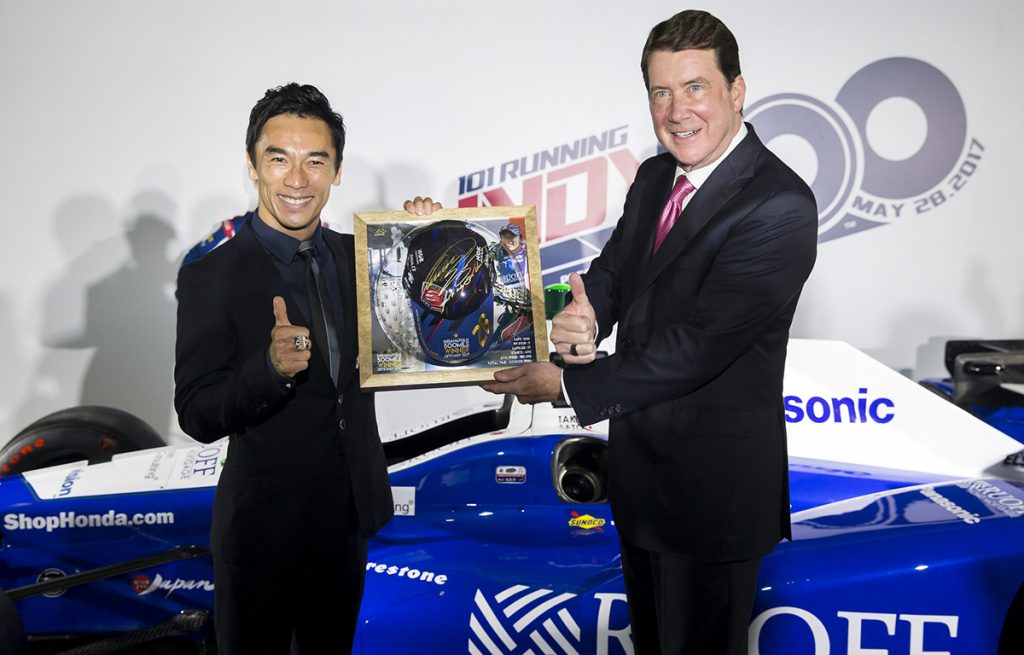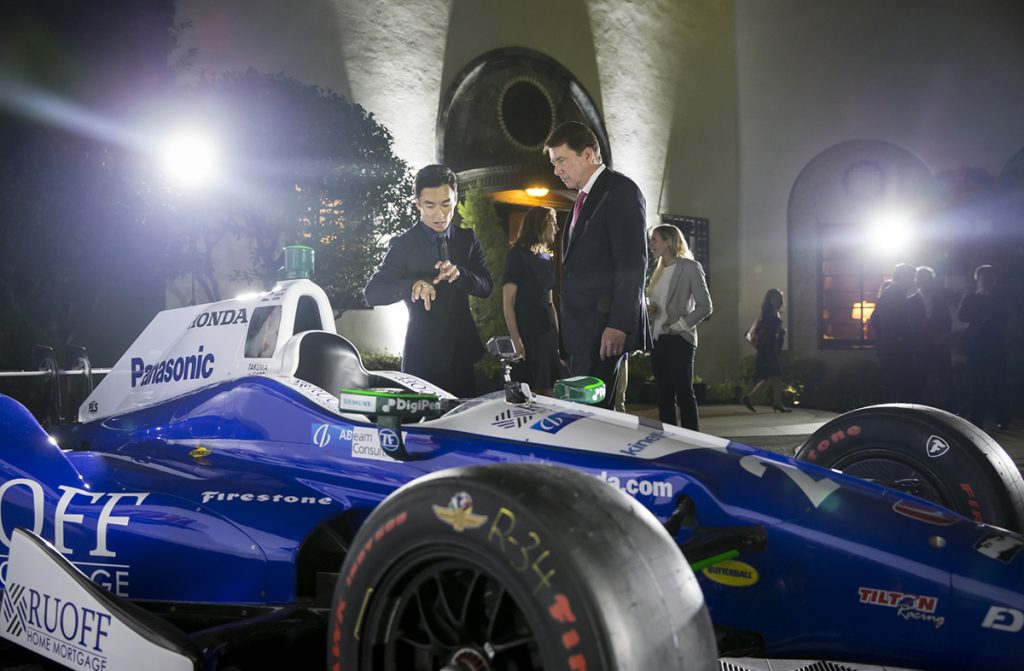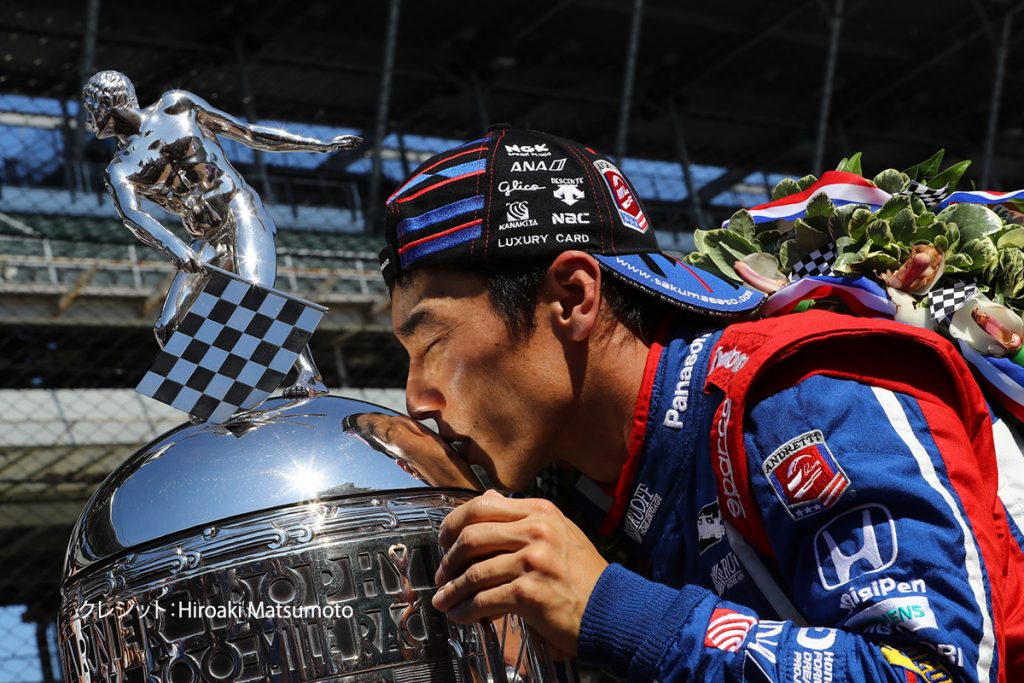In May 2017, professional racing driver Takuma Sato became the first Japanese to win the Indianapolis 500 Mile Race (Indy 500). Part of the Triple Crown of Motorsport, the Indy 500 is one of the races in the IndyCar Series. The race is 500 miles long, as the name implies, and is completed in just under four hours. Unlike Formula 1 (F1), there are rigorous restrictions on racing machines for the Indy 500. This means that the driver’s skill and teamwork have a greater influence on the outcome than the racecar’s performance.
On Oct. 11, U.S. Ambassador to Japan William Hagerty held a reception at his residence to celebrate Sato’s victory in the demanding race. In his opening remarks, Ambassador Hagerty congratulated Sato on his victory in the field of motorsports, which have long been an integral part of America’s sports culture. The Ambassador noted that American and Japanese manufacturers were responsible for the thousands of precision parts that went into making Sato’s racing machine. Pointing out that Japanese companies drive job creation in the United States, the Ambassador concluded by saying that when the U.S. and Japan work together, both countries win.

Indy 500 winner Takuma Sato poses with Ambassador Hagerty in front of the winning car.
In his remarks at the reception, Sato said he had dreamed of winning the Indy 500 ever since he was a child and never gave up on that lofty goal even though he faced many challenges along the way. Based on his motto, “No attack, no chance,” he kept reminding himself that opportunities only come to those who challenge themselves.
At the age of 10, Sato decided he wanted to be a racecar driver. He competed in cycling when he was in high school because he wasn’t able to participate in motorsports yet. After overcoming various hurdles, he started driving racecars at the age of 20 and made his F1 debut in 2002. When his contract was terminated in 2009, he decided he would take on the IndyCar Series the following year in the United States, a country that was new to him.
Asked to recount a particularly memorable experience, Sato mentioned the final lap of the 2012 Indy 500. He was coming up on the leader, who had won the 2011 race, and he made a move for the lead. He was not successful in overtaking the leader and ended up coming in 17th, but he says he doesn’t regret trying. In accordance with his philosophy of “No attack, no chance,” he went for the win. That, he says, is what is important.
Fast-forward five years to 2017. He attempted the Indy 500 again and won, fulfilling his long-cherished dream.
But Sato is not done dreaming yet. His next dream is to be the IndyCar Series champion. Sato continues to challenge himself with his eyes fixed firmly on that goal.

Takuma Sato explains the mechanics of his car to Ambassador Hagerty.
Sato’s passion for achieving his dreams has inspired many people. Panasonic is one of Sato’s official sponsors, and we spoke to Panasonic Senior Managing Executive Officer Masahisa Shibata and Executive Officer Masashi Nagayasu about him.
“I was inspired by Sato’s drive and thought Panasonic could learn something from him as a company,” said Shibata. Both executives expressed their gratitude for Sato, saying that his victory in the Indy 500 has energized their employees, who work hard every day but rarely have the opportunity to feel that their efforts are helping to realize such a big dream. Shibata and Nagayasu went on to say that since Sato’s victory has boosted Panasonic’s employees’ pride in their work, they will continue to support him in achieving his dreams.

Takuma Sato kisses his Indy 500 trophy.(Photo credit:Hiroaki Matsumoto)
In closing, Sato offered the following message to young people who are nervous about taking the first step toward realizing their dreams: “You may face many hurdles in trying to achieve your dreams, but it’s your passion to get what you want that is the key. If you take this passion and use it to do whatever it takes to get closer to your dreams, you will be able to attain them. I too faced many hurdles and limitations, but opportunity came because I always tried to move forward. ‘No attack, no chance’ is my motto. Opportunities only come to those who challenge themselves. I want you to keep challenging yourself, drawing on the energy of youth.”







COMMENTS4
Good page. Further useful descriptions are here. I’m going to give this to some friends and share it is always sweet. Naturally, we thank you for your sweat!
Amazing Post. In any case, I am satisfied with the papers which have important and informative remarks. It’s fascinating how many people talk about whether they interact with them or their customers because their experience will help you afterward.
Thanks for sharing this news. I look forward to your posts, as they often contain valuable material.
Inspiring man for all of us
Inspiring blog post thanks for share
LEAVE A COMMENT
TOP